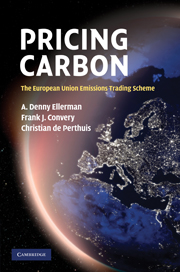Book contents
- Frontmatter
- Contents
- List of figures
- List of tables
- List of boxes
- List of appendices
- Frequently used abbreviations
- Preface
- 1 Introduction
- 2 Origins and development of the EU ETS
- 3 Allowance allocation
- 4 Effects of free allocation
- 5 Market development
- 6 Emissions abatement
- 7 Industrial competitiveness
- 8 Costs
- 9 Linkage and global implications
- 10 Conclusions
- Annex: The interaction between the EU ETS and European electricity markets
- Appendix A Sequence of events in the development of the EU ETS and Linking Directives
- Appendix B Data tables
- Bibliography
- Index
6 - Emissions abatement
Published online by Cambridge University Press: 05 July 2011
- Frontmatter
- Contents
- List of figures
- List of tables
- List of boxes
- List of appendices
- Frequently used abbreviations
- Preface
- 1 Introduction
- 2 Origins and development of the EU ETS
- 3 Allowance allocation
- 4 Effects of free allocation
- 5 Market development
- 6 Emissions abatement
- 7 Industrial competitiveness
- 8 Costs
- 9 Linkage and global implications
- 10 Conclusions
- Annex: The interaction between the EU ETS and European electricity markets
- Appendix A Sequence of events in the development of the EU ETS and Linking Directives
- Appendix B Data tables
- Bibliography
- Index
Summary
Introduction
The objective of a cap-and-trade system is often expressed as reducing emissions by a given amount, but no cap-and-trade system can guarantee any given reduction. All that is assured is that the cap, the absolute limit on emissions over some relevant period of time, will be observed. The actual reduction of emissions, or abatement, will depend on what emissions would otherwise have been, given all the conditions prevailing at that time except the price on emissions, or what is called counterfactual emissions. For instance, if economic growth is stronger (or weaker) than expected, counterfactual emissions would be higher (or lower) than expected, and the reduction in emissions required in order to stay within the cap would be commensurately greater (or smaller). What is assured by the cap is that the level of emissions will be limited regardless of all the other conditions that may obtain. Instead, it is the price and the quantity of abatement that will vary.
Abatement is a matter of particular interest in the EU ETS because emissions during the trial period were significantly lower than the cap. This slack condition is frequently referred to as over-allocation, which implies that the cap was set too high, often with the further implication that there was no abatement. This slack condition is an ex post condition, however, and, in the EU ETS, a significant CO2 price prevailed for almost two years until the slack condition became widely recognized.
- Type
- Chapter
- Information
- Pricing CarbonThe European Union Emissions Trading Scheme, pp. 158 - 192Publisher: Cambridge University PressPrint publication year: 2010
- 1
- Cited by



